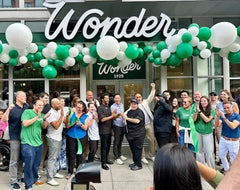
Amazon's Prime Day Surge: Analyzing the Impact on Online Retail Spending
Table of Contents
- Key Highlights:
- Introduction
- The Prime Day Phenomenon
- Shifting Consumer Behavior
- The Role of Advertising in Prime Day Success
- Success Stories: Brands Capitalizing on Prime Day
- Challenges for Higher-Priced Goods
- The Broader Implications for Retail
- Looking Ahead: Future of Prime Day and Online Retail
- FAQ
Key Highlights:
- Online spending across US retailers increased by 30.3% to $24.1 billion during Amazon's Prime Day, exceeding expectations.
- Consumers focused on essential household items, with two-thirds of purchases under $20, amidst inflationary pressures.
- Amazon leveraged an extended four-day Prime Day to boost Prime subscriptions and advertising revenues, while competitors like Walmart and Target also held parallel sales.
Introduction
Amazon's annual Prime Day event has evolved into a significant driver of consumer spending and online retail dynamics. This year, the sale's expansion from two to four days not only provided shoppers with more time to explore deals but also showcased shifting consumer behaviors influenced by economic factors. Amid rising inflation and cautious spending habits, the focus of many shoppers gravitated towards affordable essentials rather than high-ticket luxury items. This article delves into the intricacies of this year's Prime Day, examining the broader impact on the retail landscape and the strategies employed by brands to capitalize on this lucrative selling period.
The Prime Day Phenomenon
Amazon originally launched Prime Day in 2015 as a marketing strategy to boost its Prime membership subscriptions. Over the years, it has transformed into a major shopping event comparable to Black Friday, drawing millions of shoppers eager for discounts. In 2023, the event garnered a staggering $24.1 billion in sales, marking a 30.3% increase from the previous year. This figure surpassed Adobe Inc.'s forecast of 28.4% growth, indicating a robust rebound in online consumer spending.
The significance of Prime Day extends beyond Amazon. Competitors like Walmart and Target seized the opportunity to promote their own sales, creating a competitive environment that further encouraged consumer spending. This year’s event highlighted how interconnected the online retail ecosystem has become, with various players vying for the attention of budget-conscious shoppers.
Shifting Consumer Behavior
As inflation continues to affect household budgets, consumer behavior has shifted dramatically. The data indicates that two-thirds of items purchased during Prime Day were priced under $20. This trend underscores a growing preference for essentials rather than indulgent purchases. Households spent an average of $156, focusing on practical goods like dish soap and paper plates instead of expensive electronics or luxury items.
For many consumers, the ongoing uncertainty in the economy, driven in part by trade policies and inflation, has led to more cautious spending. Shoppers are increasingly prioritizing necessities, reflecting a fundamental shift in their purchasing strategies. This shift poses both challenges and opportunities for retailers looking to capture consumer interest during such sales events.
The Role of Advertising in Prime Day Success
Amazon's strategy for Prime Day has expanded significantly, particularly in the realm of advertising. The elongated sales period not only aimed at boosting direct sales but also provided a unique opportunity for the platform to enhance its advertising revenue. By lengthening the event, Amazon could offer more ad placements to merchants and brands looking to promote their products.
Jared Belsky, CEO of the digital marketing agency Acadia, points out that Prime Day has evolved into a broader advertising strategy. It is no longer confined to just sponsored search ads; instead, it involves comprehensive marketing campaigns that build momentum over time. Brands are recognizing the potential of this strategy, leading to increased investment in advertising during the lead-up to Prime Day.
Success Stories: Brands Capitalizing on Prime Day
The Prime Day event has proven advantageous for many brands, particularly those positioned to offer affordable products. One noteworthy example is Elavi, a low-sugar nut butter brand founded by entrepreneurs Michelle Razavi and Nikki Elliott. Sensing a market opportunity amidst the cost-conscious consumer trend, Elavi increased its marketing budget and offered a 20% discount on its blue cashew butter. This strategic move propelled the brand to become a best-seller in its category, demonstrating the power of aligning product offerings with consumer demand during high-traffic shopping events.
Razavi, the CEO of Elavi, expressed the importance of seizing the moment. "With our product being less than $15, we knew it would perform exceptionally well in this high traffic environment, so we’d be stupid not to advertise and get in on that action," she stated. This case exemplifies how smaller brands can leverage the Prime Day phenomenon to enhance their visibility and sales through targeted marketing efforts.
Challenges for Higher-Priced Goods
While many brands thrived during Prime Day, those offering high-ticket items faced significant hurdles. Products imported from countries with high tariffs, such as China, saw decreased consumer interest, leading some brands to opt out of the event altogether or limit their discounts. Notably, only 3% of items purchased during Prime Day were priced over $100, indicating a clear consumer preference for lower-priced goods.
The struggles of higher-priced items highlight the necessity for brands to adapt their strategies in response to changing consumer priorities. As shoppers become increasingly price-sensitive, brands must consider how to compete effectively in a market skewed toward affordability.
The Broader Implications for Retail
The outcomes of Prime Day resonate beyond Amazon and its competitors, reflecting broader trends within the retail landscape. The substantial growth in online spending during the event signals a resurgence in e-commerce, particularly as consumers continue to embrace the convenience of shopping online. This shift emphasizes the necessity for retailers to innovate and adapt to the evolving preferences of their customer base.
Moreover, the success of Prime Day illustrates how major sales events can serve as critical touchpoints for customer engagement. Retailers that effectively leverage these opportunities can strengthen their market position while fostering customer loyalty. As brands and retailers analyze consumer behaviors during such events, they can develop more refined strategies that cater to the needs and desires of today’s shoppers.
Looking Ahead: Future of Prime Day and Online Retail
As Amazon prepares for future iterations of Prime Day, the retail landscape will likely continue to evolve. The lessons learned from this year's event—particularly concerning consumer behavior and advertising strategies—will shape how retailers approach major sales in the future.
In a climate where economic uncertainties persist, the focus on affordability is expected to remain paramount. Retailers must prioritize understanding their customer base and adapting their offerings accordingly. The combination of strategic marketing, competitive pricing, and effective engagement will be crucial for success in the fast-paced world of online retail.
FAQ
What is Prime Day?
Prime Day is an annual shopping event created by Amazon for its Prime members, offering significant discounts on a wide range of products. It has grown in scope and popularity since its inception in 2015.
How did Prime Day 2023 perform compared to previous years?
In 2023, Prime Day generated $24.1 billion in sales, marking a 30.3% increase from the previous year and surpassing estimates. This indicates a robust recovery in online spending.
Why did consumers focus on lower-priced items during Prime Day 2023?
Economic factors, including inflation, have caused consumers to prioritize essential items and affordable goods over luxury purchases. This shift reflects a cautious approach toward spending amidst ongoing economic uncertainties.
How are brands adapting their strategies for Prime Day?
Brands are increasingly focusing on advertising and marketing efforts to capitalize on the high traffic generated during Prime Day. Many are adjusting their product offerings to align with consumer preferences for affordable items.
What implications does Prime Day have for the future of retail?
The outcomes of Prime Day highlight the growing importance of e-commerce and the need for retailers to innovate in response to consumer behavior. Retailers must adapt their strategies to maintain competitiveness in an evolving market.
당신의 전자상거래를 우리의 주간 통찰력과 업데이트로 강화하세요!
상거래 세계에서 일어나는 일에 대한 정보를 계속 업데이트하세요
이메일 주소
당신을 위해 엄선했습니다


14 July 2025 / Blog
Fahim Siddiqui Bids Farewell to The Home Depot: A Legacy of Transformation and Innovation
더 읽기


